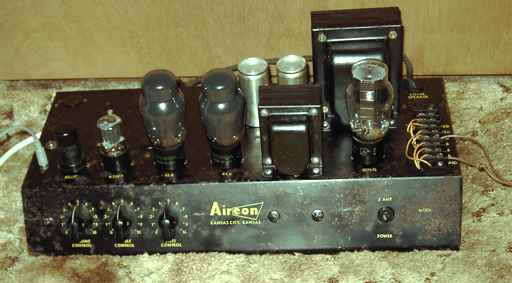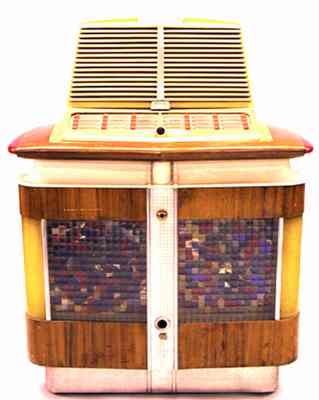

I bought this Aireon audio amplifier at an auction primarily for the transformers. The unit was sold without tubes. I did not know that the amp had been part of a jukebox when I bought it.


One jukebox pictured below was named the Aireon 1200A Super De Luxe but was nicknamed the Airliner because of its size.

Troubleshooting
After deciding that the Aireon amp should be repaired rather than used for parts, I made a power cord that would adapt to its existing power input pigtail and 4 pin plug. I located a pair of 6L6G output tubes, a 5U4G rectifier, a 6SJ7 preamp tube, and a 6SN7 phase inverter. I do not have a schematic but the circuit is fairly straightforward. The circuit is class AB1. The 500 ohm tap on the output transformer is also used for the inverse feedback circuit.
Cosmetics
The amp chassis has a fair amount of mild surface corrosion. Since it is black, it would be easy to repaint. However, painting the unit would require replacement of all the white lettering and logo. I will hold off painting for now.
Line voltage
While the power transformer stayed comfortably cool, the B+ read 420 volts with my line voltage input. I would recommend using a bucking arrangement to operate this amp at the line voltage for which this amp was probably designed and limiting the B+ to a maximum of 400 volts for greater tube and electrolytic life.
Uses for the amp
Since this amp was designed for that great "jukebox" sound, it would serve as a fine second amp for stereo playback for the typical monaural jukebox when feeding a jukebox and this amp from external line audio sources.
The Aireon logo and the "Prepro" logo
By the 1950's Aireon had stopped making jukeboxes. I spotted their unique logo design with a trapezoid in a May 1953 CQ ad (page 88) for a 100 watt ham transmitter, the Prepro. Like the three letter "eon" in Aireon, the three letters "pro" in Prepro are in identical trapezoids. The Prepro was made in Kansas City, hardly a coincidence. Does anyone have a Prepro transmitter?
Update
The Aireon amp has moved to another good home in order to rejoin an Aireon juke box.
4-05 update 9-09
The National NC-Sixty Special was the previous item on the bench.